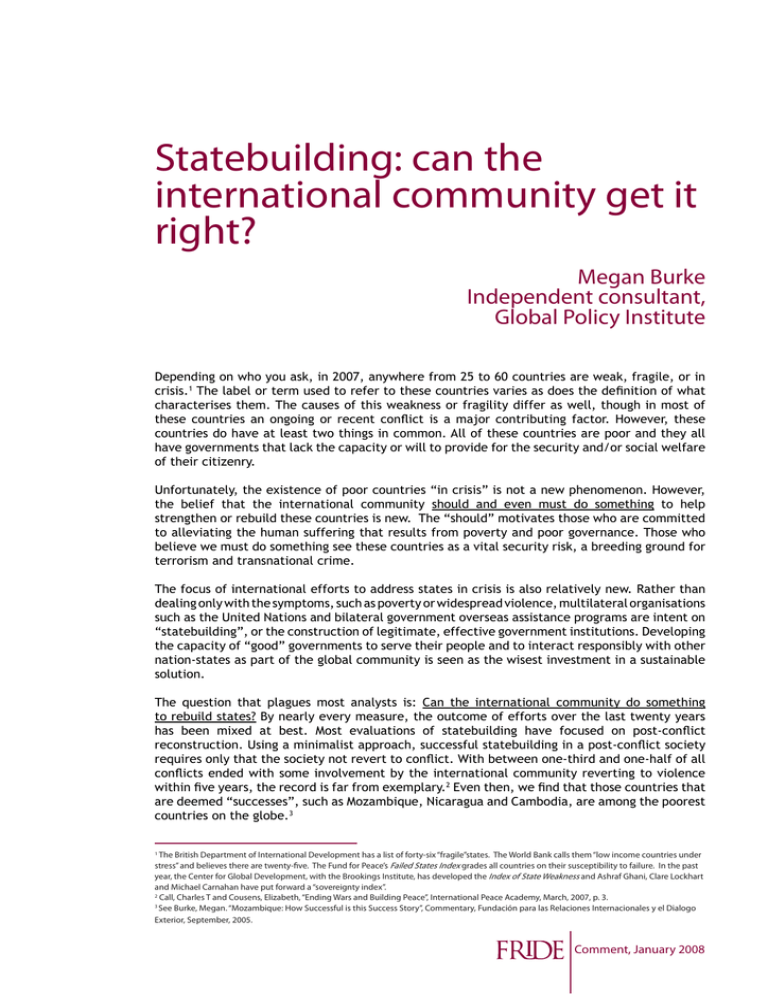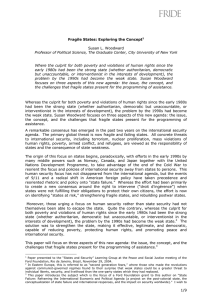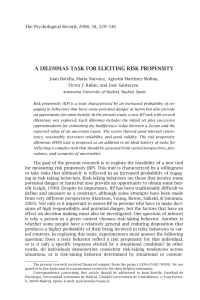Statebuilding: can the international community get it right?
Anuncio

Statebuilding: can the international community get it right? Megan Burke Independent consultant, Global Policy Institute Depending on who you ask, in 2007, anywhere from 25 to 60 countries are weak, fragile, or in crisis.1 The label or term used to refer to these countries varies as does the definition of what characterises them. The causes of this weakness or fragility differ as well, though in most of these countries an ongoing or recent conflict is a major contributing factor. However, these countries do have at least two things in common. All of these countries are poor and they all have governments that lack the capacity or will to provide for the security and/or social welfare of their citizenry. Unfortunately, the existence of poor countries “in crisis” is not a new phenomenon. However, the belief that the international community should and even must do something to help strengthen or rebuild these countries is new. The “should” motivates those who are committed to alleviating the human suffering that results from poverty and poor governance. Those who believe we must do something see these countries as a vital security risk, a breeding ground for terrorism and transnational crime. The focus of international efforts to address states in crisis is also relatively new. Rather than dealing only with the symptoms, such as poverty or widespread violence, multilateral organisations such as the United Nations and bilateral government overseas assistance programs are intent on “statebuilding”, or the construction of legitimate, effective government institutions. Developing the capacity of “good” governments to serve their people and to interact responsibly with other nation-states as part of the global community is seen as the wisest investment in a sustainable solution. The question that plagues most analysts is: Can the international community do something to rebuild states? By nearly every measure, the outcome of efforts over the last twenty years has been mixed at best. Most evaluations of statebuilding have focused on post-conflict reconstruction. Using a minimalist approach, successful statebuilding in a post-conflict society requires only that the society not revert to conflict. With between one-third and one-half of all conflicts ended with some involvement by the international community reverting to violence within five years, the record is far from exemplary.2 Even then, we find that those countries that are deemed “successes”, such as Mozambique, Nicaragua and Cambodia, are among the poorest countries on the globe.3 1 The British Department of International Development has a list of forty-six “fragile”states. The World Bank calls them “low income countries under stress” and believes there are twenty-five. The Fund for Peace’s Failed States Index grades all countries on their susceptibility to failure. In the past year, the Center for Global Development, with the Brookings Institute, has developed the Index of State Weakness and Ashraf Ghani, Clare Lockhart and Michael Carnahan have put forward a “sovereignty index”. 2 Call, Charles T and Cousens, Elizabeth, “Ending Wars and Building Peace”, International Peace Academy, March, 2007, p. 3. 3 See Burke, Megan. “Mozambique: How Successful is this Success Story”, Commentary, Fundación para las Relaciones Internacionales y el Dialogo Exterior, September, 2005. Comment, January 2008 2 Three new publications confront this question of “Can we do it?” head on. All three publications take a step beyond most previous critiques of statebuilding or peacebuilding programs. Early analyses reviewed lessons learned of various projects or national case studies to identify problems such as limited or poorly timed funding, improper sequencing of political or economic programs and a general lack of trained civilian staff. However, the recent setback in Timor L’este and the seemingly endless international presence in Bosnia and Herzegovina have led some to wonder if the lessons we have learned have brought us much closer to true success. These three publications seem to herald a new generation of reflection on statebuilding that takes a much broader view, questioning the approach of the industry as a whole. Stewart Patrick and Kaysie Brown, in Greater than the Sum of Its Parts, take an in-depth look at progress towards greater coherence in overseas assistance directed at what they refer to as “fragile states” from seven major donor governments.4 In Ending Wars and Building Peace, Charles T. Call and Elizabeth Cousens ask “Whether external actors have the knowledge, tools, resources or legitimacy to contribute to what is frequently referred to as ‘state-building’”?5 Faced with what they refer to as “disappointing results”, Roland Paris and Timothy D. Sisk in Managing Contradictions: The Inherent Dilemmas of Postwar Statebuiding challenge the international community to “manage” the inherent dilemmas that result when an external actor strives to create self-government and local ownership of the statebuilding process.6 Patrick and Brown’s analysis selects a specific goal set by Development Assistance Committee of the Organisation for Economic Cooperation and Development (OECD-DAC), that of greater donor coherence towards fragile states, and questions whether or not progress has been made. After an exhaustive look at donor policy in seven countries, including numerous interviews and document reviews, they conclude that it has not. “The rhetorical commitment of many OECD governments to integrate their defense, diplomatic, development and other interventions in the world’s weakest countries has outpaced practical steps in this direction”.7 Among the many obstacles they find to such coherence are the lack of a common definition of “fragile states”, agreement on the purpose of policy coherence and a strategic vision to guide efforts. Patrick and Brown note that “the concept of state ‘fragility’ remains contested and controversial” and that an effective, coordinated approach would require, at the very least, “a common understanding of what a ‘fragile state’ is”.8 Given the absence of such a consensus on how to approach or even identify fragile states, the more important question might be whether or not donor coherence is the right goal. Perhaps inadvertently, Patrick and Brown have uncovered the fact there is no widely accepted policy around which to cohere. Until there is some evidence of what works, donors may be better off supporting a variety of approaches with the aim to get it right. Call and Cousens pose fundamental questions about the role of the international community in statebuilding, raising concerns about both the capacity and the legitimacy of external actors. In an attempt to determine the efficacy of international efforts, they provide a very useful chronological review of advancements in peacebuilding and statebuilding, two interrelated concepts they believe should be complimentary but that can undermine one another if not closely coordinated. They catalogue a number of lessons learned in these fields, leading up to recent institutional reforms, such as the Peacebuilding Commission at the UN, and assess the degree to which these changes are likely to lead to improved outcomes. Their conclusions do not inspire much hope. On the capacity side, “It is not clear that we are anywhere close to having international policy machinery or instruments that can reliably handle multiple high4 Patrick, Stewart and Brown, Kaysie, Greater than the Sum of Its Parts? Assessing “Whole of Government” Approaches to Fragile States, International Peace Academy, 2007. 5 Call and Cousens, p. 1. 6 Paris, Roland and Sisk, Timothy, D., “Managing Contradictions: The Inherent Dilemmas of Postwar Statebuilding”, International Peace Academy, November, 2007, p. 1. 7 Patrick and Brown, p. 129. 8 Patrick and Brown, p. 128. Statebuilding: can the international community get it right? Megan Burke 3 profile peacebuilding operations successfully... ”.9 They leave the question of legitimacy to linger, without providing any satisfying conclusions in either direction. Paris and Sisk also highlight concerns about international legitimacy along with other, similarly thorny contradictions and dilemmas confronting international involvement in statebuilding. Their piece, a summary of research findings carried out by the Research Partnership on Postwar Statebuilding (RPPS), pushes the international community to go beyond “lessons learned” to consider the tensions, contradictions and dilemmas that are inherent in its efforts to build states on behalf of the citizens of those states.10 The five tensions and contradictions they name go to the heart of the matter. What happens when outside intervention is used to foster self-government? Can foreigners participate in identifying legitimate and appropriate local “owners”? Will the “universal values” promoted by external actors be seen as legitimate within the host society? Paris and Sisk do not claim to have answers to these questions. However, they do believe that the international community must continue to have a role in statebuilding so as not to “abandon tens of millions of people to lawlessness, predation, disease and fear”.11 They recognise that there are those who argue in favour of a greater acceptance of “autonomous recovery” with fewer or more limited international interventions. However, they assert that statebuilding remains a key global concern and thus a practice that must be improved through the management of these inherent dilemmas. There is now a growing acceptance that the responsibility of the international community to protect trumps national sovereignty and that this responsibility includes the responsibility to react and to rebuild when a government is unable or unwilling to do this itself. As such, there is little chance that members of the international community will conclude that countries on the verge of collapse should be left to their own devices. Therefore, it is refreshing to see scholars and practitioners grapple with the core challenges of statebuilding operations. These three publications, like most of the available literature on statebuilding, peacebuilding or addressing states in crisis, are written by scholars or practitioners who live in those donor countries that implement statebuilding operations on behalf of “host societies”. As such, each of these pieces could be seen as a self-critical analysis or a reflection on the practices of the authors’ own governments. What these authors cannot offer is the perspective of members of the “host societies” who must also deal with the inherent tensions that arise from international involvement in building their states. How might representatives of weak, fragile or crisis states suggest that the international community establish and maintain legitimacy and accountability to the people of these states? What are their ideas of how the international community can assist in rebuilding governments without fostering dependence? Questions of how to achieve effective international and national cooperation in statebuilding, by their very nature, seem to beg for the input from both external and internal actors. The dearth of assessment and reflection from the inside is not surprising; most countries that are candidates for international statebuilding assistance lack the infrastructure to support this kind of scholarly review. Despite these challenges, solutions must be sought to enrich the discussion with a full range of viewpoints. Hopefully, through such an enriched discussion that does not shy away from the difficult questions that these publications have raised, the third generation of such operations will have found new ways to effectively marry local ownership and international engagement within states in crisis. 9 Call and Cousens, p. 17. The Research Partnership on Postwar Statebuilding is a collaborative research project of thirteen scholars from six countries. Papers from each of the scholars are available at www.statebuilding.org 11 Paris and Sick, p. 9. 10 Comment, January 2008 4 FRIDE’s Comments provide a brief and concise analysis of current topics in international affairs in the fields of peace and security, democratisation, human rights, and humanitarian action and development. Further information about FRIDE, as well as its publications can be found at www.fride.org The views expressed by the authors of the documents published on this website do not necessarily reflect the opinion of FRIDE. If you have any comments on the articles or any other suggestions, please email us at [email protected] Fundación para las Relaciones Internacionales y el Diálogo Exterior C/ Goya, 5-7 pasaje 2ª - 28001 Madrid - Telf: 91 244 47 40 - Fax: 91 244 47 41 - E-mail : [email protected] www.fride.org Statebuilding: can the international community get it right? Megan Burke

